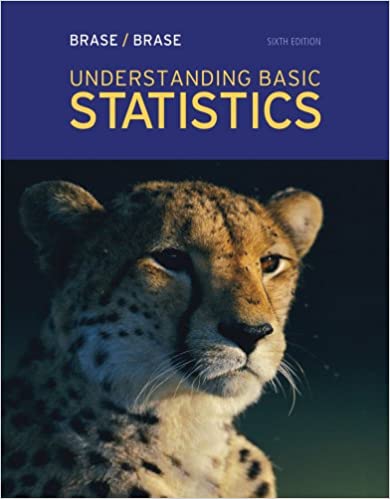
Understanding Basic Statistics 6th Edition by Charles Henry Brase,Corrinne Pellillo Brase
Edition 6ISBN: 978-1111827021
Understanding Basic Statistics 6th Edition by Charles Henry Brase,Corrinne Pellillo Brase
Edition 6ISBN: 978-1111827021 Exercise 35
Expand Your Knowledge: Two Confidence Intervals What happens if we want several confidence intervals to hold at the same time (concurrently) Do we still have the same level of confidence we had for each individual interval
(a) Suppose we have two independent random variables x 1 and x 2 with respective population means 1 and 2. Let us say that we use sample data to construct two 80% confidence intervals.

Now, what is the probability that both intervals hold at the same time
Use methods of Section 5.2 to show that
P ( A 1 1 B 1 and A 2 2 B 2 ) = 0.64
Hint: You are combining independent events. If the confidence is 64% that both intervals hold concurrently, explain why the risk that at least one interval does not hold (i.e., fails) must be 36%.
(b) Suppose we want both intervals to hold with 90% confidence (i.e., only 10% risk level). How much confidence c should each interval have to achieve this combinined level of confidence (Assume that each interval has the same confidence level c.)
Hint: P ( A 1 1 B 1 and A 2 2 B 2 ) = 0.90
P ( A 1 1 B 1 ) × P ( A 2 2 B 2 ) = 0.90
Now solve foe c.
(c) If we want both intervals to hold at the 90% level of confidence, then the individual intervals must hold at a higher level of confidence. Write a brief but detailed explanation of how this could be of importance in a large, complex engineering design such as a rocket booster or a spacecraft.
(a) Suppose we have two independent random variables x 1 and x 2 with respective population means 1 and 2. Let us say that we use sample data to construct two 80% confidence intervals.

Now, what is the probability that both intervals hold at the same time
Use methods of Section 5.2 to show that
P ( A 1 1 B 1 and A 2 2 B 2 ) = 0.64
Hint: You are combining independent events. If the confidence is 64% that both intervals hold concurrently, explain why the risk that at least one interval does not hold (i.e., fails) must be 36%.
(b) Suppose we want both intervals to hold with 90% confidence (i.e., only 10% risk level). How much confidence c should each interval have to achieve this combinined level of confidence (Assume that each interval has the same confidence level c.)
Hint: P ( A 1 1 B 1 and A 2 2 B 2 ) = 0.90
P ( A 1 1 B 1 ) × P ( A 2 2 B 2 ) = 0.90
Now solve foe c.
(c) If we want both intervals to hold at the 90% level of confidence, then the individual intervals must hold at a higher level of confidence. Write a brief but detailed explanation of how this could be of importance in a large, complex engineering design such as a rocket booster or a spacecraft.
Explanation
Here is information about two 80% confid...
Understanding Basic Statistics 6th Edition by Charles Henry Brase,Corrinne Pellillo Brase
Why don’t you like this exercise?
Other Minimum 8 character and maximum 255 character
Character 255


